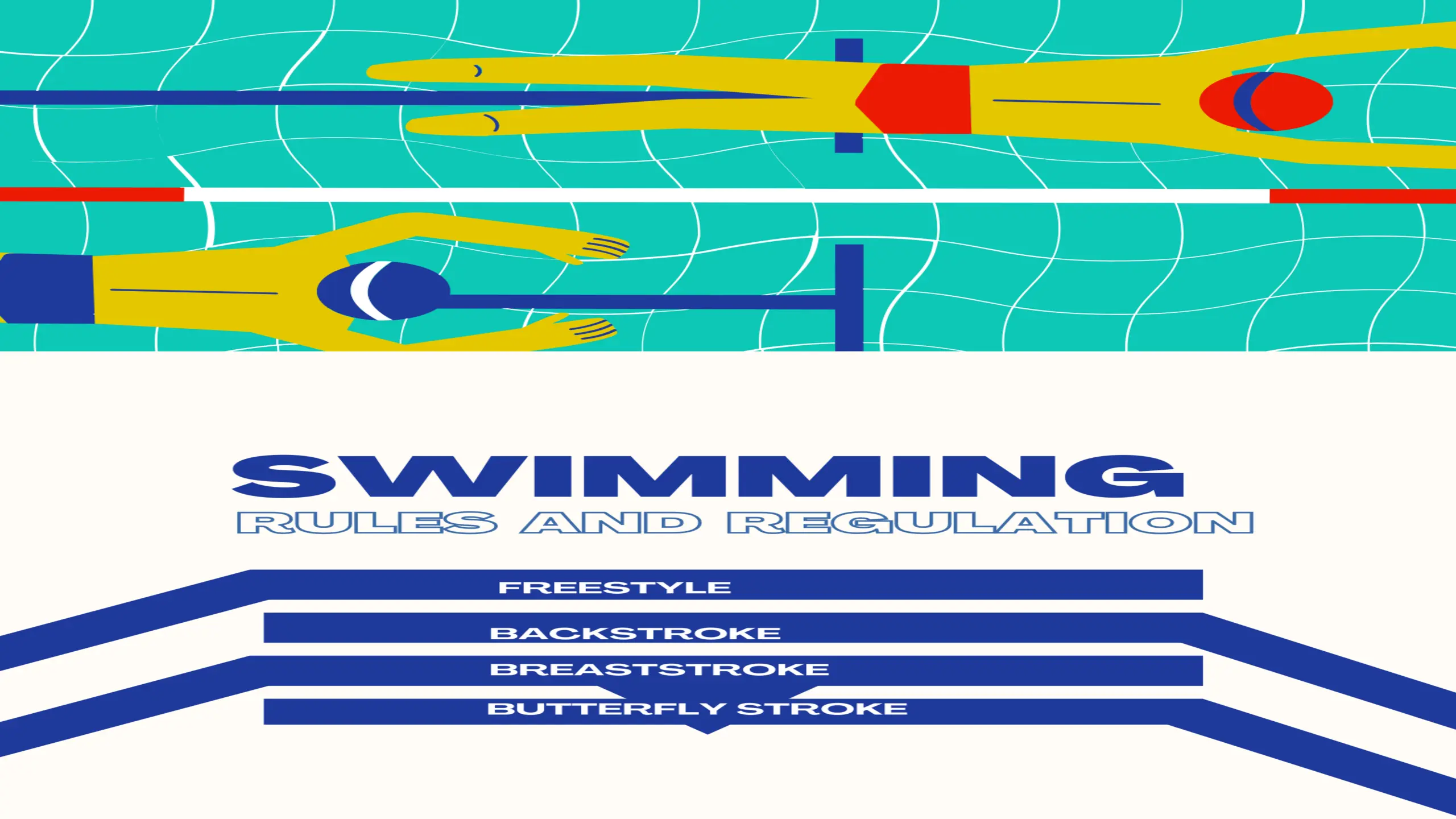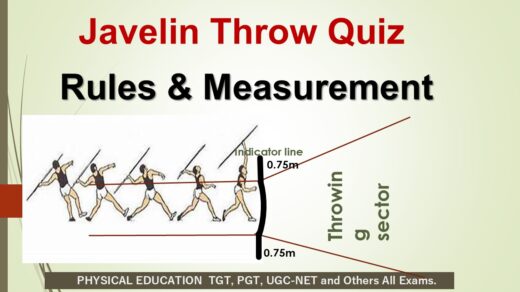Swimming: History, Pool dimensions, Rules and Regulations
Swimming is not just a sport but a skill that has been practiced for centuries, dating back to ancient Egyptian, Greek, and Roman civilizations. This blog post delves into the rich history of swimming, its evolution as a competitive sport, and the fundamental rules that govern it today.
History of Swimming
Ancient Civilizations:
- Swimming has its roots in ancient civilizations where it was a necessary skill for survival and warfare.
- In Greece and Rome, swimming lessons were a part of the curriculum.
The First Competitions:
- The first recorded swimming competition took place in Britain in 1830, predominantly featuring the breaststroke.
- By 1846, Australia hosted the first 440-yard race, marking the sport’s growing popularity.
Olympic Inclusion:
- Swimming made its Olympic debut in 1896 in Athens, featuring events for men only.
- It wasn’t until 1912 in Stockholm that women were allowed to compete.
- The first modern Olympic swimming champion was Alfred Hajos of Hungary, who won gold in the 100m freestyle.
Record Breakers:
- In 1922, Johnny Weissmuller (USA) became the first swimmer to complete the 100m in under a minute, earning the title of the world’s fastest swimmer. Weissmuller later became famous for his role as Tarzan in Hollywood films.
Swimming Federations
FINA:
- The Federation Internationale de Natation (FINA) was established on July 19, 1908, and governs international competitions.
- Its headquarters are in Lausanne, Switzerland.
AASF:
The Asia Swimming Federation (AASF), founded in 1978 in Bangkok, oversees swimming activities in Asia, with headquarters in Muscat, Oman.
SFI:
- The Swimming Federation of India (SFI) was founded in 1948.
- It is headquartered in Ahmedabad, Gujarat.
Swimming Pool Specifications
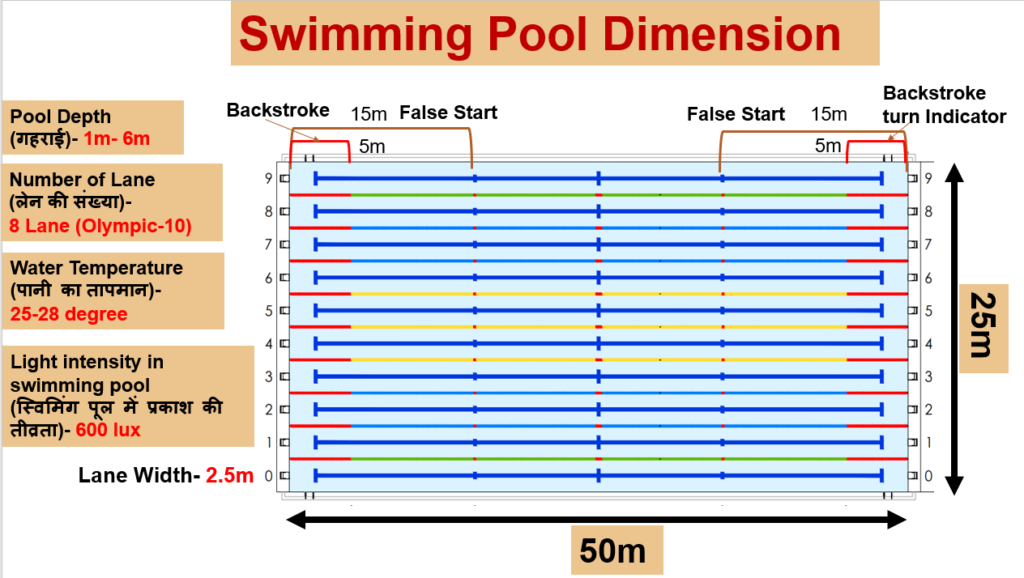
- Dimensions: Pools are typically 25m or 50m long.
- Lanes: Number of lane is 8 but Olympic pool has 10 lanes, each 2.5m wide.
- Depth: Pool depth ranges from 1m to 6m.
- Temperature: Water temperature is maintained between 25-28 degrees Celsius.
- Light Intensity: 600 lux is the standard lighting intensity.
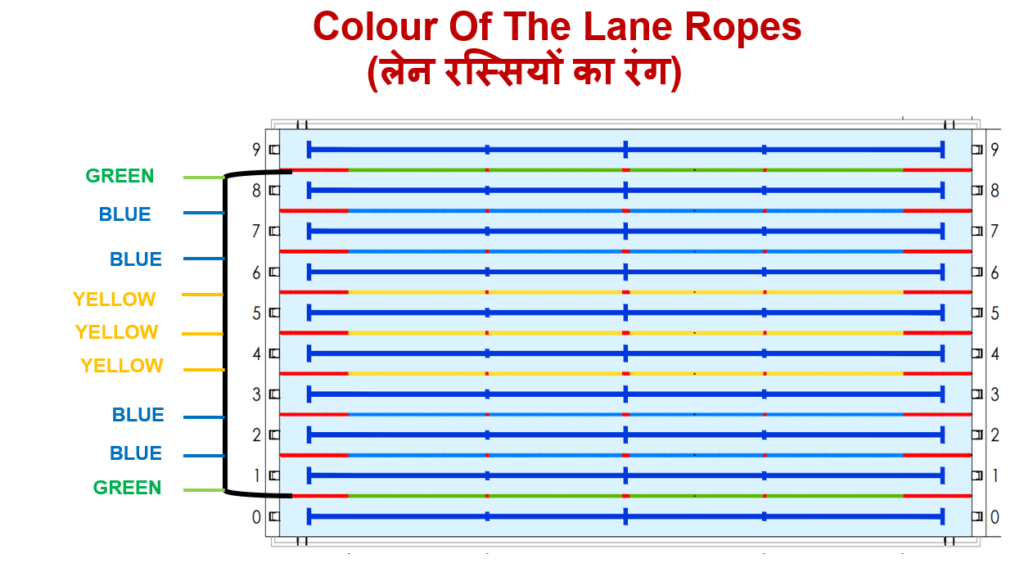
The color of lane ropes in a swimming pool is typically organized as follows:
- Green: The ropes marking the outermost lanes.
- Blue: The ropes marking the second and third lanes from the outside.
- Yellow: The ropes marking the middle lanes.
This color coding helps swimmers quickly identify their lanes and maintain proper alignment during races.
Styles of Swimming
Swimming styles, also known as strokes, are techniques used by swimmers to move efficiently through the water. Each stroke has its own unique set of movements and rules, which are recognized in competitive swimming events. Here are the four primary swimming styles:
1. Freestyle (Front Crawl)

Technique:
- Body Position: Horizontal and streamlined.
- Arm Movement: Alternating circular motions. One arm pulls underwater while the other recovers above water.
- Leg Movement: Continuous flutter kick with legs straight and toes pointed.
- Breathing: Typically to the side, coordinated with the arm recovery.
Advantages:
- Fastest and most efficient stroke.
- Allows for quick and easy breathing adjustments.
Competitive Distances:
- 50m, 100m, 200m, 400m, 800m, and 1500m.
2. Backstroke

Technique:
- Body Position: Lying on the back with a streamlined body.
- Arm Movement: Alternating arm strokes; one arm pulls underwater while the other recovers over water.
- Leg Movement: Continuous flutter kick similar to freestyle.
- Breathing: Face remains above water, allowing for natural breathing.
Advantages:
- Breathing is easier as the face is always above water.
- Provides good visibility for backstroke events.
Competitive Distances:
- 100m and 200m.
3. Breaststroke
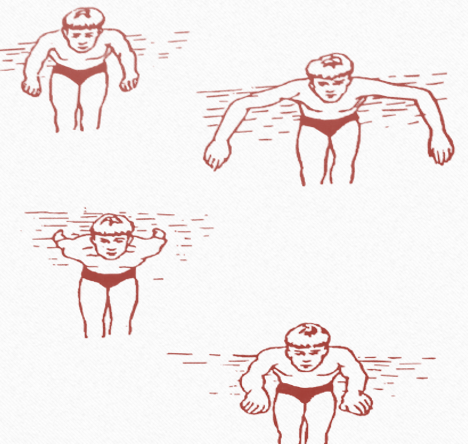
Technique:
- Body Position: Horizontal with a slight incline.
- Arm Movement: Both arms move in a half-circular motion simultaneously, sweeping out and then pulling back together.
- Leg Movement: Frog kick or whip kick, where legs move in a circular motion.
- Breathing: Head lifts out of the water during the pull phase for inhalation.
Advantages:
- Can be easier to learn for beginners.
- Efficient for long-distance swimming.
Competitive Distances:
- 100m and 200m.
4. Butterfly Stroke
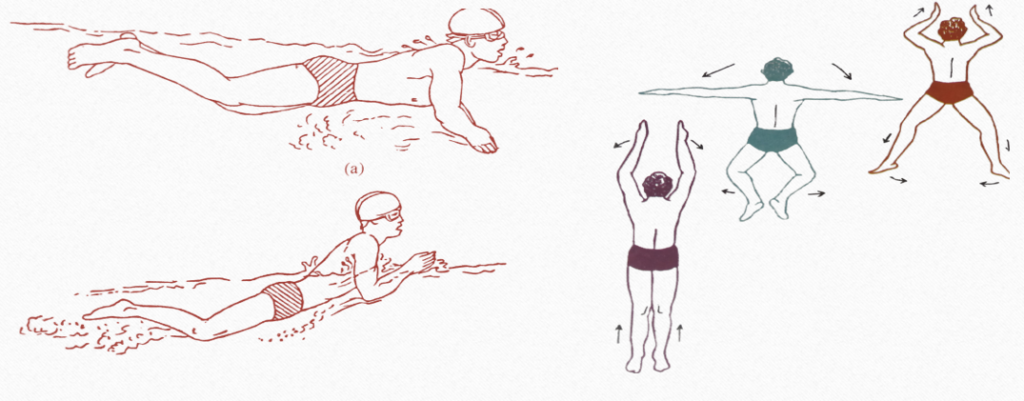
Technique:
- Body Position: Horizontal and streamlined.
- Arm Movement: Both arms move in a windmill motion together, pulling underwater and recovering above water.
- Leg Movement: Dolphin kick, where both legs move up and down together.
- Breathing: Typically forward during the arm recovery phase, though it can be done to the side.
Advantages:
- Known for its power and speed.
- Provides a full-body workout.
Competitive Distances:
- 100m and 200m.
Swimming Event in Olympic
2020 Olympics – 37 events (18 each for men and women and 1 mixed event)
The 2020 Tokyo Games will include for the first time the women’s 1,500 and the men’s 800, finally equalizing the available events for men and Women.
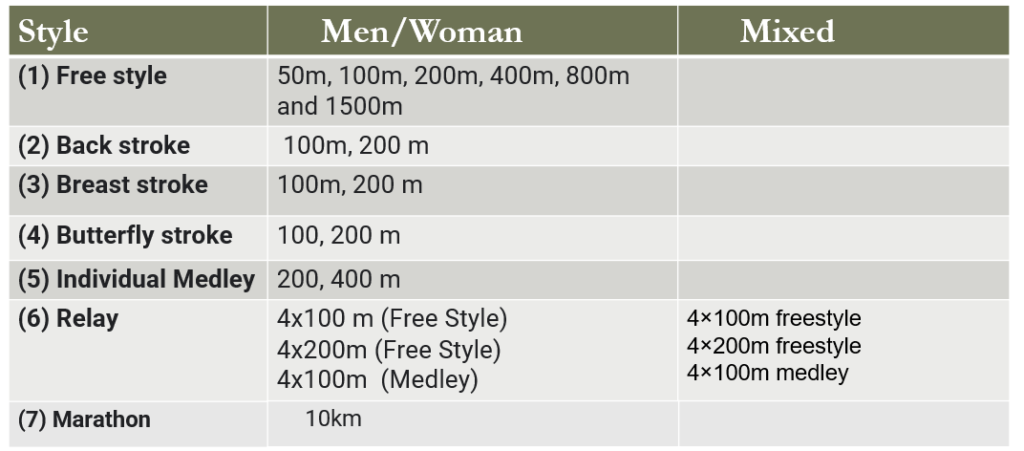
Basic Rules of Swimming
Starting:
- Races begin with a dive, except backstroke and medley relays, which start in the water.
- The start in Backstroke and Medley Relay races shall be from the water.
False Start:
- Swimmers starting before the signal are disqualified.
Turns:
- Swimmers must touch the pool end during turns without taking a step.
- In all events, a swimmer when turning shall make physical contact with the end of the pool or course.
- The turn must be made from the wall, and it is not permitted to take a stride or step from the bottom of the pool.
Finish:
- The race must end in the same lane where it started.
- A swimmer must end the race in the same lane in which the race was started.
Conduct:
- Swimmers must not obstruct others and should exit the pool immediately after finishing.
- A swimmer must end the race in the same lane in which the race was started.
- Pulling on the lane rope is not allowed.
Heats in Swimming
In competitive swimming, “heats” refer to preliminary rounds or qualifying races held to determine the fastest swimmers who will advance to the final rounds. Here’s a detailed explanation of how heats work:
Purpose of Heats
- Managing Large Numbers: Heats are used when there are too many swimmers to compete in a single race.
- Fair Competition: They ensure that swimmers compete against others of similar abilities, making the competition fairer and more organized.
How Heats Work
- Seeding:
- Swimmers are seeded based on their qualifying times. The fastest swimmers are placed in the middle lanes, which are considered advantageous due to less wave interference.
- In an 8-lane pool, the fastest swimmer is usually placed in lane 4, the second fastest in lane 5, and so on. In a 10-lane pool, the fastest is placed in lane 5, and the second fastest in lane 6.
- Multiple Rounds:
- Depending on the number of participants, there may be several heats for each event.
- The number of heats depends on the number of entries and the number of lanes available in the pool.
- Advancement:
- Swimmers’ times in the heats determine who advances to the next round, typically the semifinals or finals.
- In some meets, the top finishers in each heat plus the next fastest times overall advance to the finals.
- Fastest Times:
- Advancing swimmers are usually determined by the fastest times rather than heat placements.
- This ensures that the best swimmers progress, regardless of the competition in their specific heat.
Roles of Swimming Officials
In competitive swimming, officials play crucial roles to ensure that the events are conducted fairly and smoothly. Here is an overview of the key officials and their responsibilities:
1. Referee
- Role: The overall authority in a swimming meet.
- Responsibilities: Ensures that all FINA rules are followed, resolves any disputes, and has the power to disqualify swimmers for rule infractions. Signals the start of each race and oversees the entire event.
2. Starter
- Role: Controls the start of each race.
- Responsibilities: Ensures swimmers are positioned correctly on the blocks and signals the start using a starting pistol or electronic device. Watches for false starts and may disqualify swimmers for early takeoffs.
3. Judge of Strokes
- Role: Monitors the swimmers to ensure they comply with stroke regulations.
- Responsibilities: Observes swimmers from the sides of the pool to verify that each stroke is executed according to the rules (e.g., proper technique in breaststroke, butterfly, backstroke, and freestyle).
4. Inspector of Turns
- Role: Ensures swimmers perform legal turns and finishes.
- Responsibilities: Stationed at each end of the pool, they watch for correct touch and turn techniques, ensuring swimmers don’t push off the wall improperly or miss the wall during turns.
5. Timekeeper
- Role: Records the time each swimmer takes to complete their race.
- Responsibilities: Operates a stopwatch or timing system for their assigned lane, noting the times and ensuring accuracy. Multiple timekeepers may be assigned to each lane for reliability.
6. Clerk of Course
- Role: Manages the organization and flow of swimmers to their events.
- Responsibilities: Ensures swimmers are in the correct place at the right time for their heats, organizing and assembling them before they move to the starting blocks.
7. Control-room Supervisor
- Role: Manages the data and timing systems.
- Responsibilities: Oversees the collection and processing of race results, ensuring accurate and timely reporting of times and placements. Works with timekeepers and electronic timing systems.
8. Finish Judge
- Role: Determines the official order of finish.
- Responsibilities: Observes and records the order in which swimmers touch the wall at the end of the race. This role is crucial when electronic timing systems are not in use or fail.
Swimming is a sport that requires not only physical strength and endurance but also adherence to strict rules and regulations. Its historical significance and the evolution of its competitive nature make it a fascinating and revered sport worldwide.
Think you know everything about swimming? Take on the ultimate swimming quiz and prove your aquatic expertise by clicking here.
If you want to watch video on this topic click here.
Download PDF here.

